An Examination of Work, Gender, and Societal Dynamics
VerifiedAdded on 2023/01/23
|10
|2989
|52
Essay
AI Summary
This essay delves into the intricate relationship between work, encompassing both paid and unpaid labor, and gender within society. It examines the evolution of gender roles, the division of labor, and the impact of societal changes on these dynamics. The essay explores how economic structures and family dynamics influence women's employment and involvement in both paid and unpaid work, analyzing shifts in household responsibilities and the challenges faced by women in the workforce. It discusses the concept of gender inequality in the job market and the influence of caregiving roles on women's participation in demanding professions. Furthermore, it reviews the impact of societal policies and cultural norms on the relationship between work, gender, and the overall societal structure, providing insights into the complexities of gendered labor and its implications.
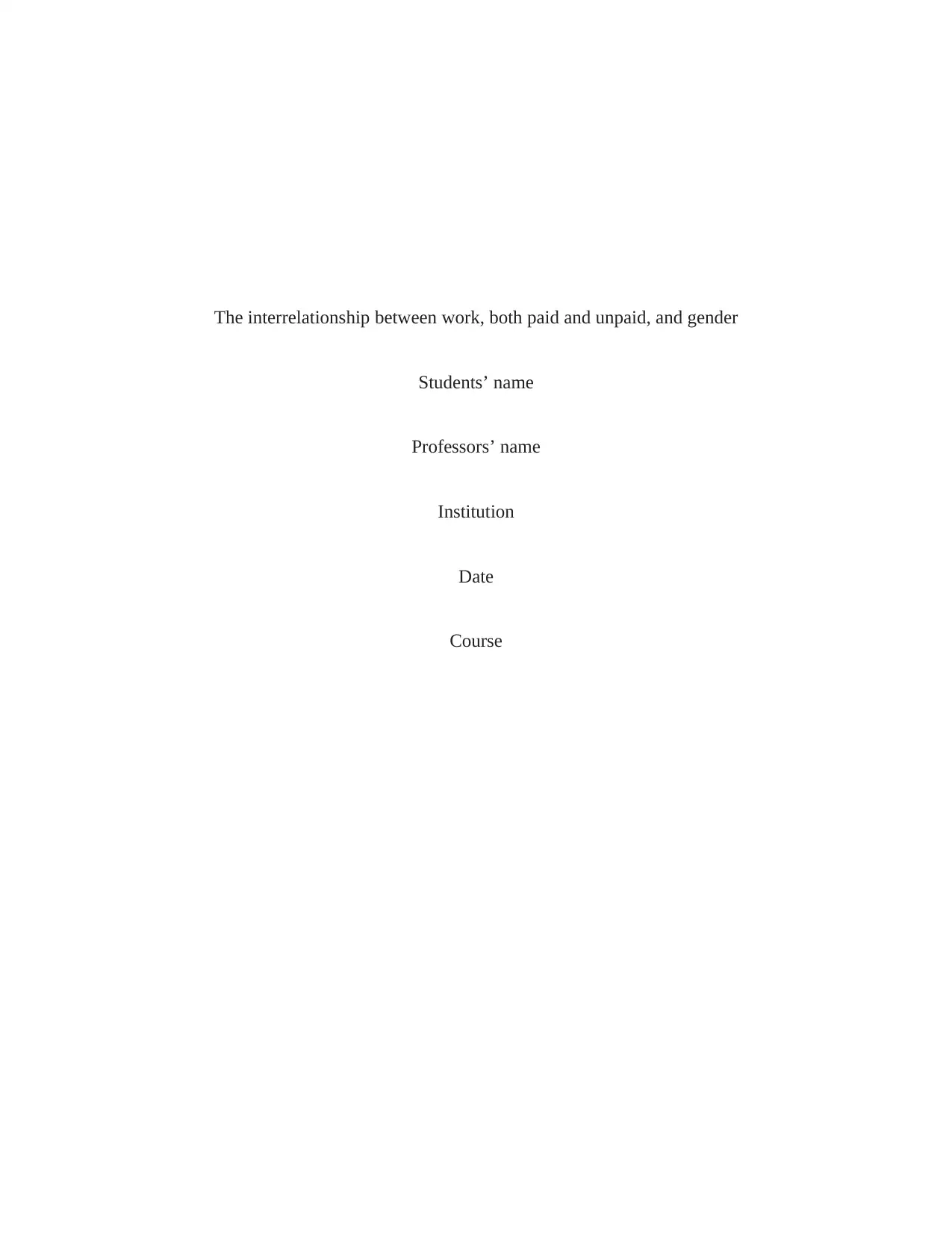
The interrelationship between work, both paid and unpaid, and gender
Students’ name
Professors’ name
Institution
Date
Course
Students’ name
Professors’ name
Institution
Date
Course
Paraphrase This Document
Need a fresh take? Get an instant paraphrase of this document with our AI Paraphraser
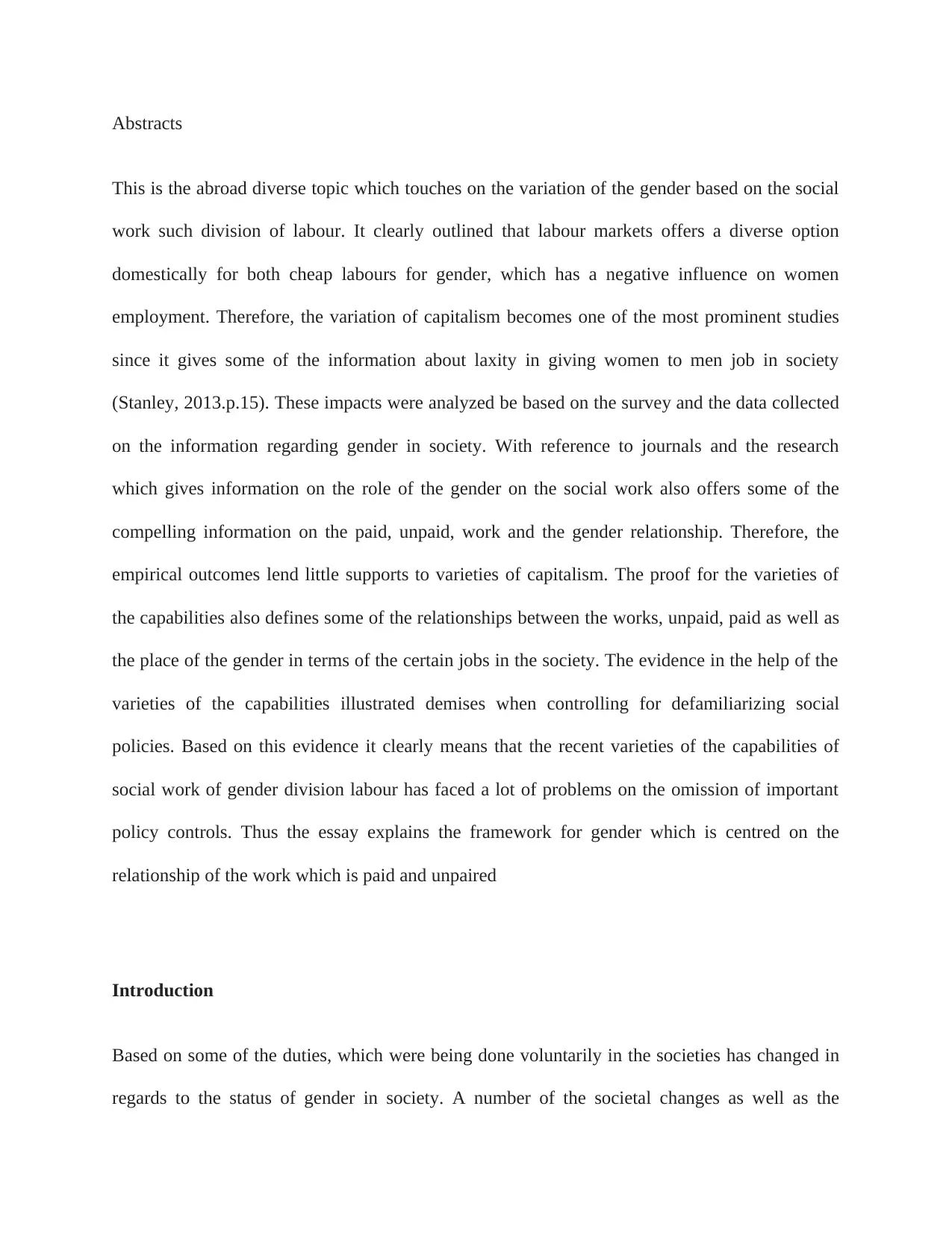
Abstracts
This is the abroad diverse topic which touches on the variation of the gender based on the social
work such division of labour. It clearly outlined that labour markets offers a diverse option
domestically for both cheap labours for gender, which has a negative influence on women
employment. Therefore, the variation of capitalism becomes one of the most prominent studies
since it gives some of the information about laxity in giving women to men job in society
(Stanley, 2013.p.15). These impacts were analyzed be based on the survey and the data collected
on the information regarding gender in society. With reference to journals and the research
which gives information on the role of the gender on the social work also offers some of the
compelling information on the paid, unpaid, work and the gender relationship. Therefore, the
empirical outcomes lend little supports to varieties of capitalism. The proof for the varieties of
the capabilities also defines some of the relationships between the works, unpaid, paid as well as
the place of the gender in terms of the certain jobs in the society. The evidence in the help of the
varieties of the capabilities illustrated demises when controlling for defamiliarizing social
policies. Based on this evidence it clearly means that the recent varieties of the capabilities of
social work of gender division labour has faced a lot of problems on the omission of important
policy controls. Thus the essay explains the framework for gender which is centred on the
relationship of the work which is paid and unpaired
Introduction
Based on some of the duties, which were being done voluntarily in the societies has changed in
regards to the status of gender in society. A number of the societal changes as well as the
This is the abroad diverse topic which touches on the variation of the gender based on the social
work such division of labour. It clearly outlined that labour markets offers a diverse option
domestically for both cheap labours for gender, which has a negative influence on women
employment. Therefore, the variation of capitalism becomes one of the most prominent studies
since it gives some of the information about laxity in giving women to men job in society
(Stanley, 2013.p.15). These impacts were analyzed be based on the survey and the data collected
on the information regarding gender in society. With reference to journals and the research
which gives information on the role of the gender on the social work also offers some of the
compelling information on the paid, unpaid, work and the gender relationship. Therefore, the
empirical outcomes lend little supports to varieties of capitalism. The proof for the varieties of
the capabilities also defines some of the relationships between the works, unpaid, paid as well as
the place of the gender in terms of the certain jobs in the society. The evidence in the help of the
varieties of the capabilities illustrated demises when controlling for defamiliarizing social
policies. Based on this evidence it clearly means that the recent varieties of the capabilities of
social work of gender division labour has faced a lot of problems on the omission of important
policy controls. Thus the essay explains the framework for gender which is centred on the
relationship of the work which is paid and unpaired
Introduction
Based on some of the duties, which were being done voluntarily in the societies has changed in
regards to the status of gender in society. A number of the societal changes as well as the
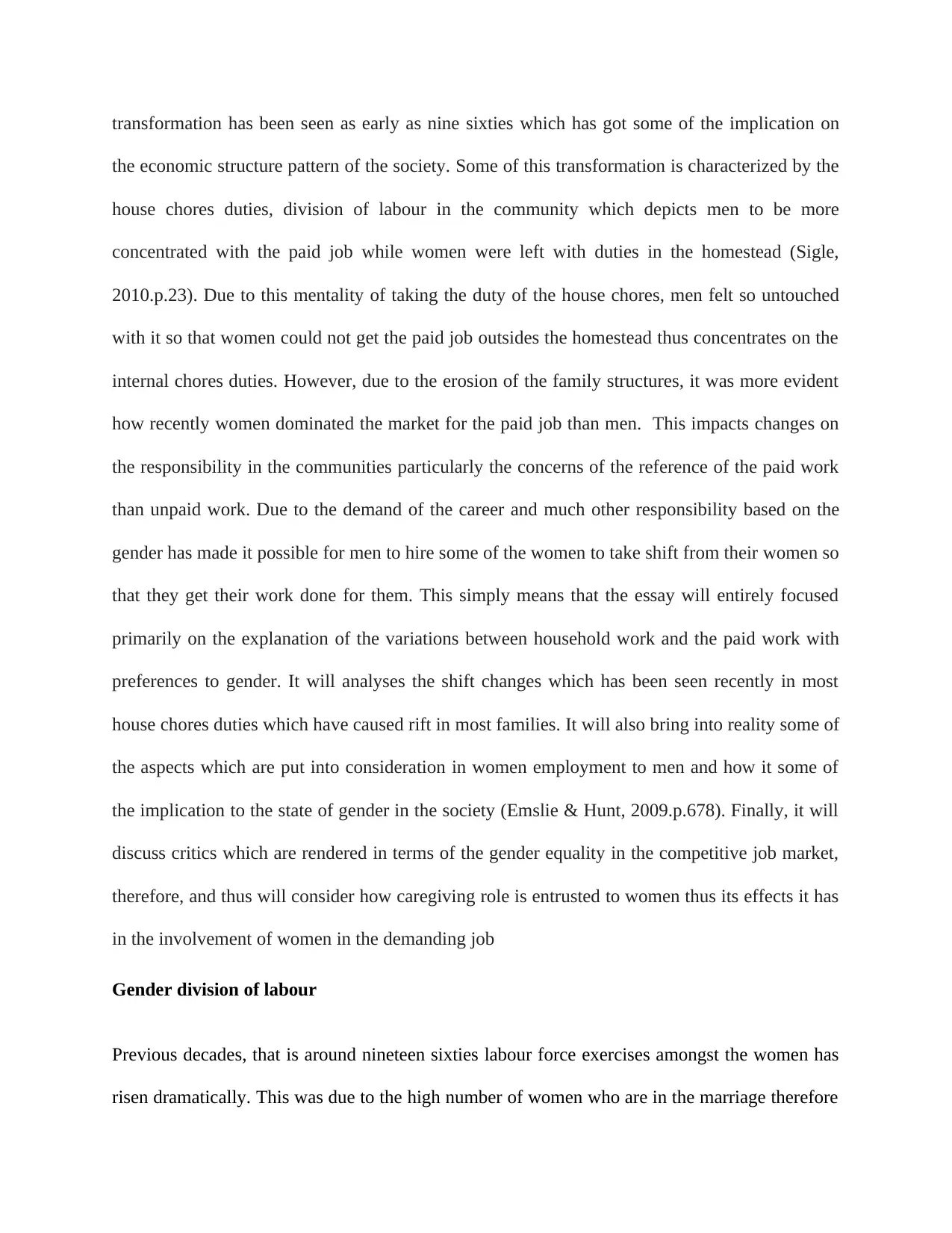
transformation has been seen as early as nine sixties which has got some of the implication on
the economic structure pattern of the society. Some of this transformation is characterized by the
house chores duties, division of labour in the community which depicts men to be more
concentrated with the paid job while women were left with duties in the homestead (Sigle,
2010.p.23). Due to this mentality of taking the duty of the house chores, men felt so untouched
with it so that women could not get the paid job outsides the homestead thus concentrates on the
internal chores duties. However, due to the erosion of the family structures, it was more evident
how recently women dominated the market for the paid job than men. This impacts changes on
the responsibility in the communities particularly the concerns of the reference of the paid work
than unpaid work. Due to the demand of the career and much other responsibility based on the
gender has made it possible for men to hire some of the women to take shift from their women so
that they get their work done for them. This simply means that the essay will entirely focused
primarily on the explanation of the variations between household work and the paid work with
preferences to gender. It will analyses the shift changes which has been seen recently in most
house chores duties which have caused rift in most families. It will also bring into reality some of
the aspects which are put into consideration in women employment to men and how it some of
the implication to the state of gender in the society (Emslie & Hunt, 2009.p.678). Finally, it will
discuss critics which are rendered in terms of the gender equality in the competitive job market,
therefore, and thus will consider how caregiving role is entrusted to women thus its effects it has
in the involvement of women in the demanding job
Gender division of labour
Previous decades, that is around nineteen sixties labour force exercises amongst the women has
risen dramatically. This was due to the high number of women who are in the marriage therefore
the economic structure pattern of the society. Some of this transformation is characterized by the
house chores duties, division of labour in the community which depicts men to be more
concentrated with the paid job while women were left with duties in the homestead (Sigle,
2010.p.23). Due to this mentality of taking the duty of the house chores, men felt so untouched
with it so that women could not get the paid job outsides the homestead thus concentrates on the
internal chores duties. However, due to the erosion of the family structures, it was more evident
how recently women dominated the market for the paid job than men. This impacts changes on
the responsibility in the communities particularly the concerns of the reference of the paid work
than unpaid work. Due to the demand of the career and much other responsibility based on the
gender has made it possible for men to hire some of the women to take shift from their women so
that they get their work done for them. This simply means that the essay will entirely focused
primarily on the explanation of the variations between household work and the paid work with
preferences to gender. It will analyses the shift changes which has been seen recently in most
house chores duties which have caused rift in most families. It will also bring into reality some of
the aspects which are put into consideration in women employment to men and how it some of
the implication to the state of gender in the society (Emslie & Hunt, 2009.p.678). Finally, it will
discuss critics which are rendered in terms of the gender equality in the competitive job market,
therefore, and thus will consider how caregiving role is entrusted to women thus its effects it has
in the involvement of women in the demanding job
Gender division of labour
Previous decades, that is around nineteen sixties labour force exercises amongst the women has
risen dramatically. This was due to the high number of women who are in the marriage therefore
⊘ This is a preview!⊘
Do you want full access?
Subscribe today to unlock all pages.

Trusted by 1+ million students worldwide
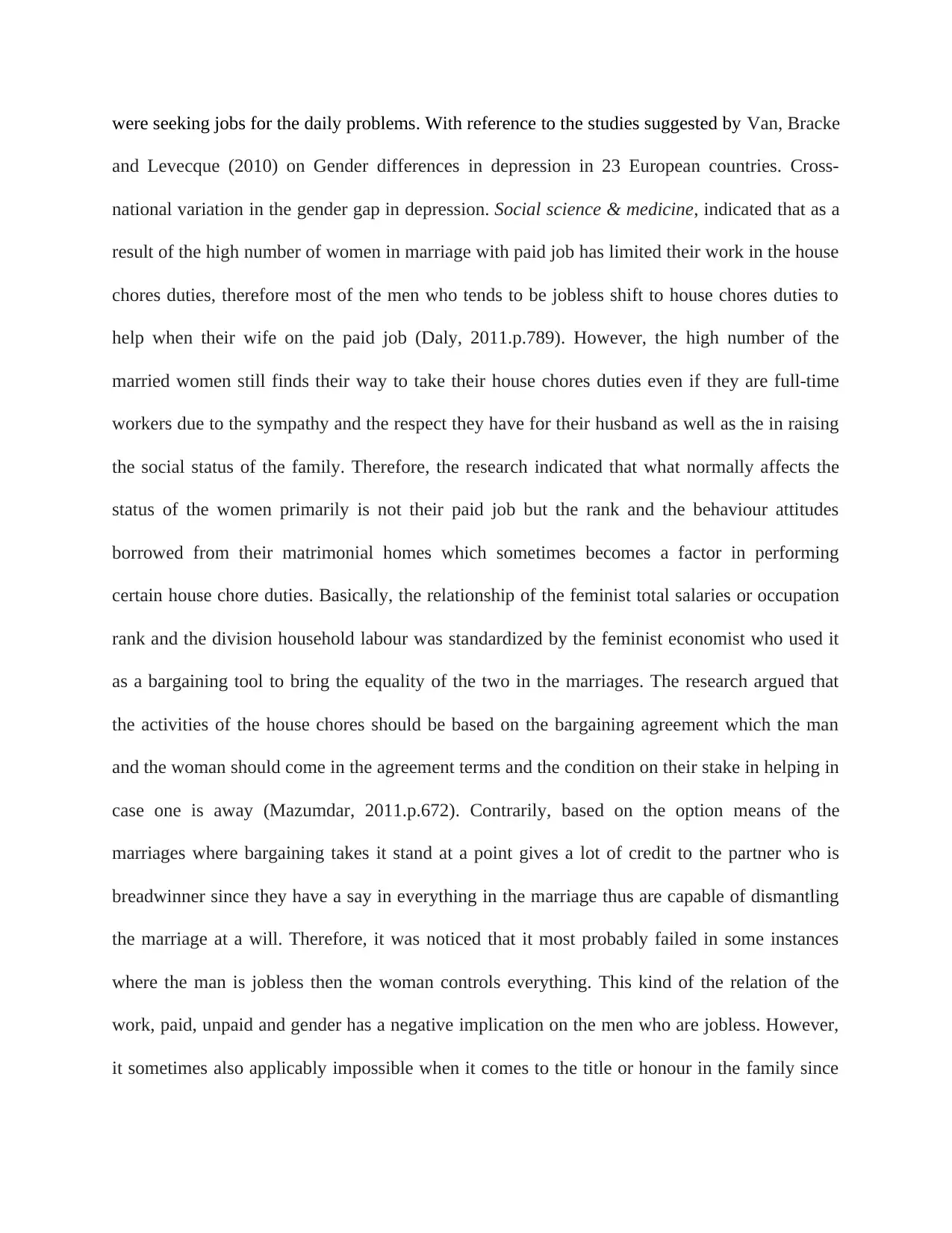
were seeking jobs for the daily problems. With reference to the studies suggested by Van, Bracke
and Levecque (2010) on Gender differences in depression in 23 European countries. Cross-
national variation in the gender gap in depression. Social science & medicine, indicated that as a
result of the high number of women in marriage with paid job has limited their work in the house
chores duties, therefore most of the men who tends to be jobless shift to house chores duties to
help when their wife on the paid job (Daly, 2011.p.789). However, the high number of the
married women still finds their way to take their house chores duties even if they are full-time
workers due to the sympathy and the respect they have for their husband as well as the in raising
the social status of the family. Therefore, the research indicated that what normally affects the
status of the women primarily is not their paid job but the rank and the behaviour attitudes
borrowed from their matrimonial homes which sometimes becomes a factor in performing
certain house chore duties. Basically, the relationship of the feminist total salaries or occupation
rank and the division household labour was standardized by the feminist economist who used it
as a bargaining tool to bring the equality of the two in the marriages. The research argued that
the activities of the house chores should be based on the bargaining agreement which the man
and the woman should come in the agreement terms and the condition on their stake in helping in
case one is away (Mazumdar, 2011.p.672). Contrarily, based on the option means of the
marriages where bargaining takes it stand at a point gives a lot of credit to the partner who is
breadwinner since they have a say in everything in the marriage thus are capable of dismantling
the marriage at a will. Therefore, it was noticed that it most probably failed in some instances
where the man is jobless then the woman controls everything. This kind of the relation of the
work, paid, unpaid and gender has a negative implication on the men who are jobless. However,
it sometimes also applicably impossible when it comes to the title or honour in the family since
and Levecque (2010) on Gender differences in depression in 23 European countries. Cross-
national variation in the gender gap in depression. Social science & medicine, indicated that as a
result of the high number of women in marriage with paid job has limited their work in the house
chores duties, therefore most of the men who tends to be jobless shift to house chores duties to
help when their wife on the paid job (Daly, 2011.p.789). However, the high number of the
married women still finds their way to take their house chores duties even if they are full-time
workers due to the sympathy and the respect they have for their husband as well as the in raising
the social status of the family. Therefore, the research indicated that what normally affects the
status of the women primarily is not their paid job but the rank and the behaviour attitudes
borrowed from their matrimonial homes which sometimes becomes a factor in performing
certain house chore duties. Basically, the relationship of the feminist total salaries or occupation
rank and the division household labour was standardized by the feminist economist who used it
as a bargaining tool to bring the equality of the two in the marriages. The research argued that
the activities of the house chores should be based on the bargaining agreement which the man
and the woman should come in the agreement terms and the condition on their stake in helping in
case one is away (Mazumdar, 2011.p.672). Contrarily, based on the option means of the
marriages where bargaining takes it stand at a point gives a lot of credit to the partner who is
breadwinner since they have a say in everything in the marriage thus are capable of dismantling
the marriage at a will. Therefore, it was noticed that it most probably failed in some instances
where the man is jobless then the woman controls everything. This kind of the relation of the
work, paid, unpaid and gender has a negative implication on the men who are jobless. However,
it sometimes also applicably impossible when it comes to the title or honour in the family since
Paraphrase This Document
Need a fresh take? Get an instant paraphrase of this document with our AI Paraphraser
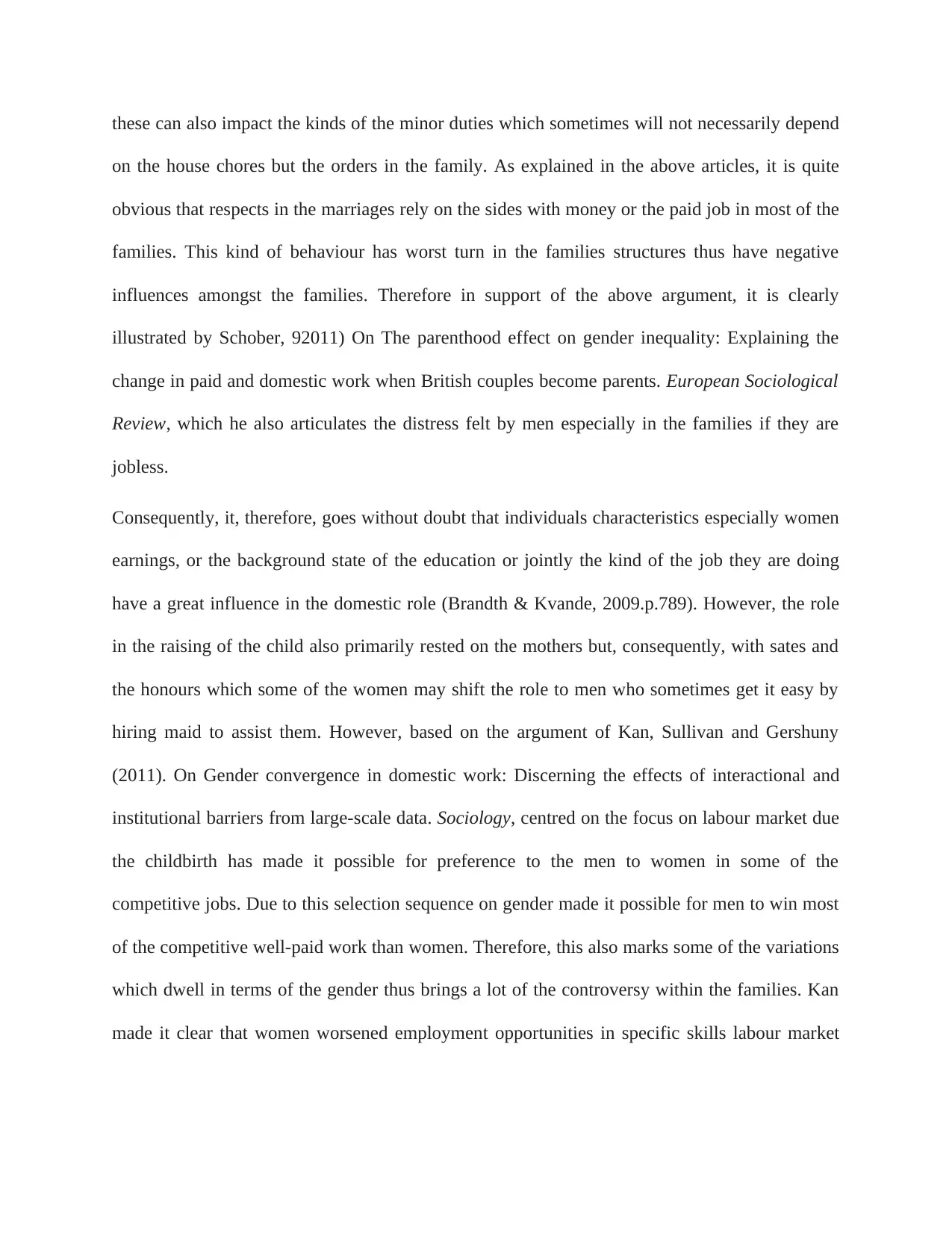
these can also impact the kinds of the minor duties which sometimes will not necessarily depend
on the house chores but the orders in the family. As explained in the above articles, it is quite
obvious that respects in the marriages rely on the sides with money or the paid job in most of the
families. This kind of behaviour has worst turn in the families structures thus have negative
influences amongst the families. Therefore in support of the above argument, it is clearly
illustrated by Schober, 92011) On The parenthood effect on gender inequality: Explaining the
change in paid and domestic work when British couples become parents. European Sociological
Review, which he also articulates the distress felt by men especially in the families if they are
jobless.
Consequently, it, therefore, goes without doubt that individuals characteristics especially women
earnings, or the background state of the education or jointly the kind of the job they are doing
have a great influence in the domestic role (Brandth & Kvande, 2009.p.789). However, the role
in the raising of the child also primarily rested on the mothers but, consequently, with sates and
the honours which some of the women may shift the role to men who sometimes get it easy by
hiring maid to assist them. However, based on the argument of Kan, Sullivan and Gershuny
(2011). On Gender convergence in domestic work: Discerning the effects of interactional and
institutional barriers from large-scale data. Sociology, centred on the focus on labour market due
the childbirth has made it possible for preference to the men to women in some of the
competitive jobs. Due to this selection sequence on gender made it possible for men to win most
of the competitive well-paid work than women. Therefore, this also marks some of the variations
which dwell in terms of the gender thus brings a lot of the controversy within the families. Kan
made it clear that women worsened employment opportunities in specific skills labour market
on the house chores but the orders in the family. As explained in the above articles, it is quite
obvious that respects in the marriages rely on the sides with money or the paid job in most of the
families. This kind of behaviour has worst turn in the families structures thus have negative
influences amongst the families. Therefore in support of the above argument, it is clearly
illustrated by Schober, 92011) On The parenthood effect on gender inequality: Explaining the
change in paid and domestic work when British couples become parents. European Sociological
Review, which he also articulates the distress felt by men especially in the families if they are
jobless.
Consequently, it, therefore, goes without doubt that individuals characteristics especially women
earnings, or the background state of the education or jointly the kind of the job they are doing
have a great influence in the domestic role (Brandth & Kvande, 2009.p.789). However, the role
in the raising of the child also primarily rested on the mothers but, consequently, with sates and
the honours which some of the women may shift the role to men who sometimes get it easy by
hiring maid to assist them. However, based on the argument of Kan, Sullivan and Gershuny
(2011). On Gender convergence in domestic work: Discerning the effects of interactional and
institutional barriers from large-scale data. Sociology, centred on the focus on labour market due
the childbirth has made it possible for preference to the men to women in some of the
competitive jobs. Due to this selection sequence on gender made it possible for men to win most
of the competitive well-paid work than women. Therefore, this also marks some of the variations
which dwell in terms of the gender thus brings a lot of the controversy within the families. Kan
made it clear that women worsened employment opportunities in specific skills labour market
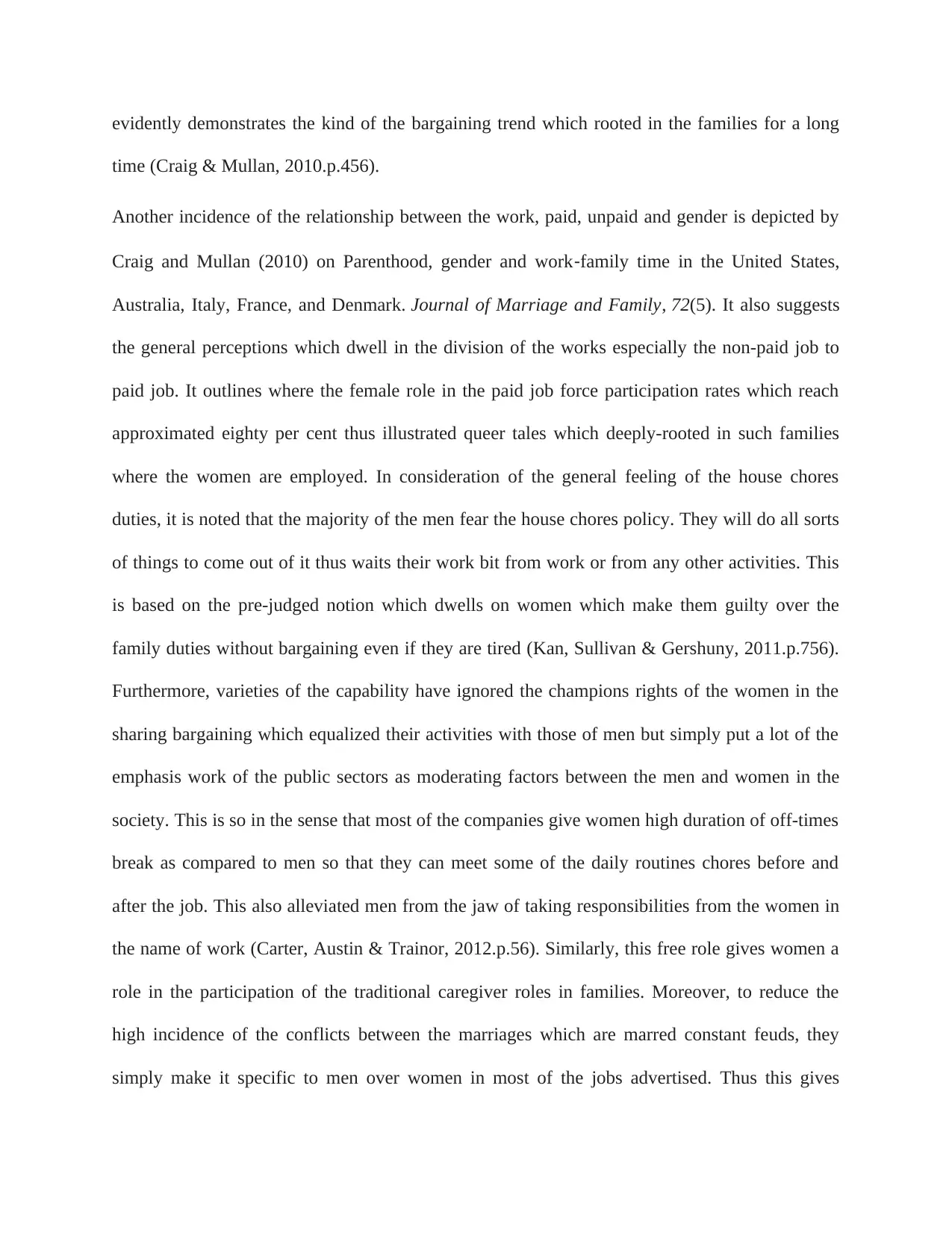
evidently demonstrates the kind of the bargaining trend which rooted in the families for a long
time (Craig & Mullan, 2010.p.456).
Another incidence of the relationship between the work, paid, unpaid and gender is depicted by
Craig and Mullan (2010) on Parenthood, gender and work‐family time in the United States,
Australia, Italy, France, and Denmark. Journal of Marriage and Family, 72(5). It also suggests
the general perceptions which dwell in the division of the works especially the non-paid job to
paid job. It outlines where the female role in the paid job force participation rates which reach
approximated eighty per cent thus illustrated queer tales which deeply-rooted in such families
where the women are employed. In consideration of the general feeling of the house chores
duties, it is noted that the majority of the men fear the house chores policy. They will do all sorts
of things to come out of it thus waits their work bit from work or from any other activities. This
is based on the pre-judged notion which dwells on women which make them guilty over the
family duties without bargaining even if they are tired (Kan, Sullivan & Gershuny, 2011.p.756).
Furthermore, varieties of the capability have ignored the champions rights of the women in the
sharing bargaining which equalized their activities with those of men but simply put a lot of the
emphasis work of the public sectors as moderating factors between the men and women in the
society. This is so in the sense that most of the companies give women high duration of off-times
break as compared to men so that they can meet some of the daily routines chores before and
after the job. This also alleviated men from the jaw of taking responsibilities from the women in
the name of work (Carter, Austin & Trainor, 2012.p.56). Similarly, this free role gives women a
role in the participation of the traditional caregiver roles in families. Moreover, to reduce the
high incidence of the conflicts between the marriages which are marred constant feuds, they
simply make it specific to men over women in most of the jobs advertised. Thus this gives
time (Craig & Mullan, 2010.p.456).
Another incidence of the relationship between the work, paid, unpaid and gender is depicted by
Craig and Mullan (2010) on Parenthood, gender and work‐family time in the United States,
Australia, Italy, France, and Denmark. Journal of Marriage and Family, 72(5). It also suggests
the general perceptions which dwell in the division of the works especially the non-paid job to
paid job. It outlines where the female role in the paid job force participation rates which reach
approximated eighty per cent thus illustrated queer tales which deeply-rooted in such families
where the women are employed. In consideration of the general feeling of the house chores
duties, it is noted that the majority of the men fear the house chores policy. They will do all sorts
of things to come out of it thus waits their work bit from work or from any other activities. This
is based on the pre-judged notion which dwells on women which make them guilty over the
family duties without bargaining even if they are tired (Kan, Sullivan & Gershuny, 2011.p.756).
Furthermore, varieties of the capability have ignored the champions rights of the women in the
sharing bargaining which equalized their activities with those of men but simply put a lot of the
emphasis work of the public sectors as moderating factors between the men and women in the
society. This is so in the sense that most of the companies give women high duration of off-times
break as compared to men so that they can meet some of the daily routines chores before and
after the job. This also alleviated men from the jaw of taking responsibilities from the women in
the name of work (Carter, Austin & Trainor, 2012.p.56). Similarly, this free role gives women a
role in the participation of the traditional caregiver roles in families. Moreover, to reduce the
high incidence of the conflicts between the marriages which are marred constant feuds, they
simply make it specific to men over women in most of the jobs advertised. Thus this gives
⊘ This is a preview!⊘
Do you want full access?
Subscribe today to unlock all pages.

Trusted by 1+ million students worldwide
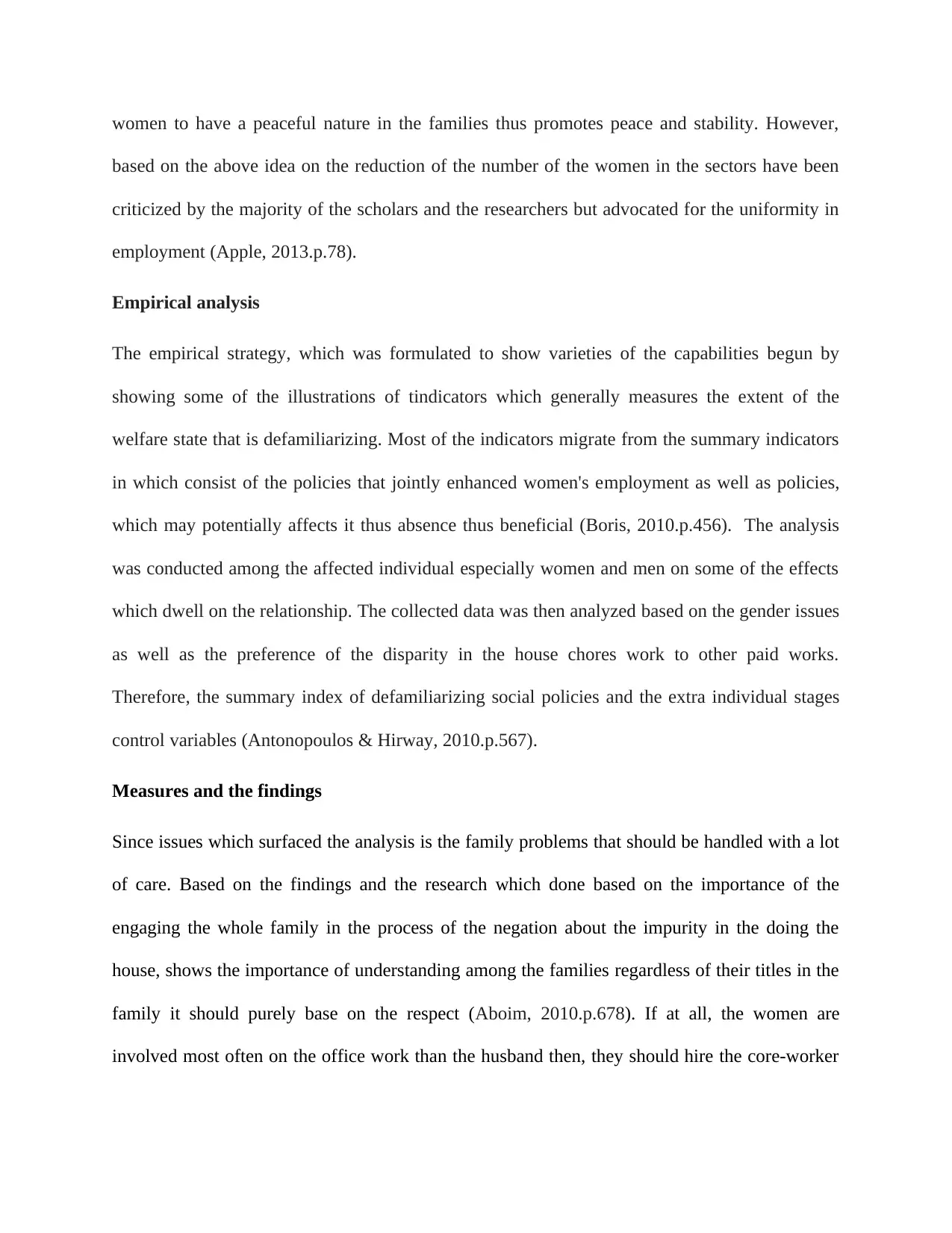
women to have a peaceful nature in the families thus promotes peace and stability. However,
based on the above idea on the reduction of the number of the women in the sectors have been
criticized by the majority of the scholars and the researchers but advocated for the uniformity in
employment (Apple, 2013.p.78).
Empirical analysis
The empirical strategy, which was formulated to show varieties of the capabilities begun by
showing some of the illustrations of tindicators which generally measures the extent of the
welfare state that is defamiliarizing. Most of the indicators migrate from the summary indicators
in which consist of the policies that jointly enhanced women's employment as well as policies,
which may potentially affects it thus absence thus beneficial (Boris, 2010.p.456). The analysis
was conducted among the affected individual especially women and men on some of the effects
which dwell on the relationship. The collected data was then analyzed based on the gender issues
as well as the preference of the disparity in the house chores work to other paid works.
Therefore, the summary index of defamiliarizing social policies and the extra individual stages
control variables (Antonopoulos & Hirway, 2010.p.567).
Measures and the findings
Since issues which surfaced the analysis is the family problems that should be handled with a lot
of care. Based on the findings and the research which done based on the importance of the
engaging the whole family in the process of the negation about the impurity in the doing the
house, shows the importance of understanding among the families regardless of their titles in the
family it should purely base on the respect (Aboim, 2010.p.678). If at all, the women are
involved most often on the office work than the husband then, they should hire the core-worker
based on the above idea on the reduction of the number of the women in the sectors have been
criticized by the majority of the scholars and the researchers but advocated for the uniformity in
employment (Apple, 2013.p.78).
Empirical analysis
The empirical strategy, which was formulated to show varieties of the capabilities begun by
showing some of the illustrations of tindicators which generally measures the extent of the
welfare state that is defamiliarizing. Most of the indicators migrate from the summary indicators
in which consist of the policies that jointly enhanced women's employment as well as policies,
which may potentially affects it thus absence thus beneficial (Boris, 2010.p.456). The analysis
was conducted among the affected individual especially women and men on some of the effects
which dwell on the relationship. The collected data was then analyzed based on the gender issues
as well as the preference of the disparity in the house chores work to other paid works.
Therefore, the summary index of defamiliarizing social policies and the extra individual stages
control variables (Antonopoulos & Hirway, 2010.p.567).
Measures and the findings
Since issues which surfaced the analysis is the family problems that should be handled with a lot
of care. Based on the findings and the research which done based on the importance of the
engaging the whole family in the process of the negation about the impurity in the doing the
house, shows the importance of understanding among the families regardless of their titles in the
family it should purely base on the respect (Aboim, 2010.p.678). If at all, the women are
involved most often on the office work than the husband then, they should hire the core-worker
Paraphrase This Document
Need a fresh take? Get an instant paraphrase of this document with our AI Paraphraser
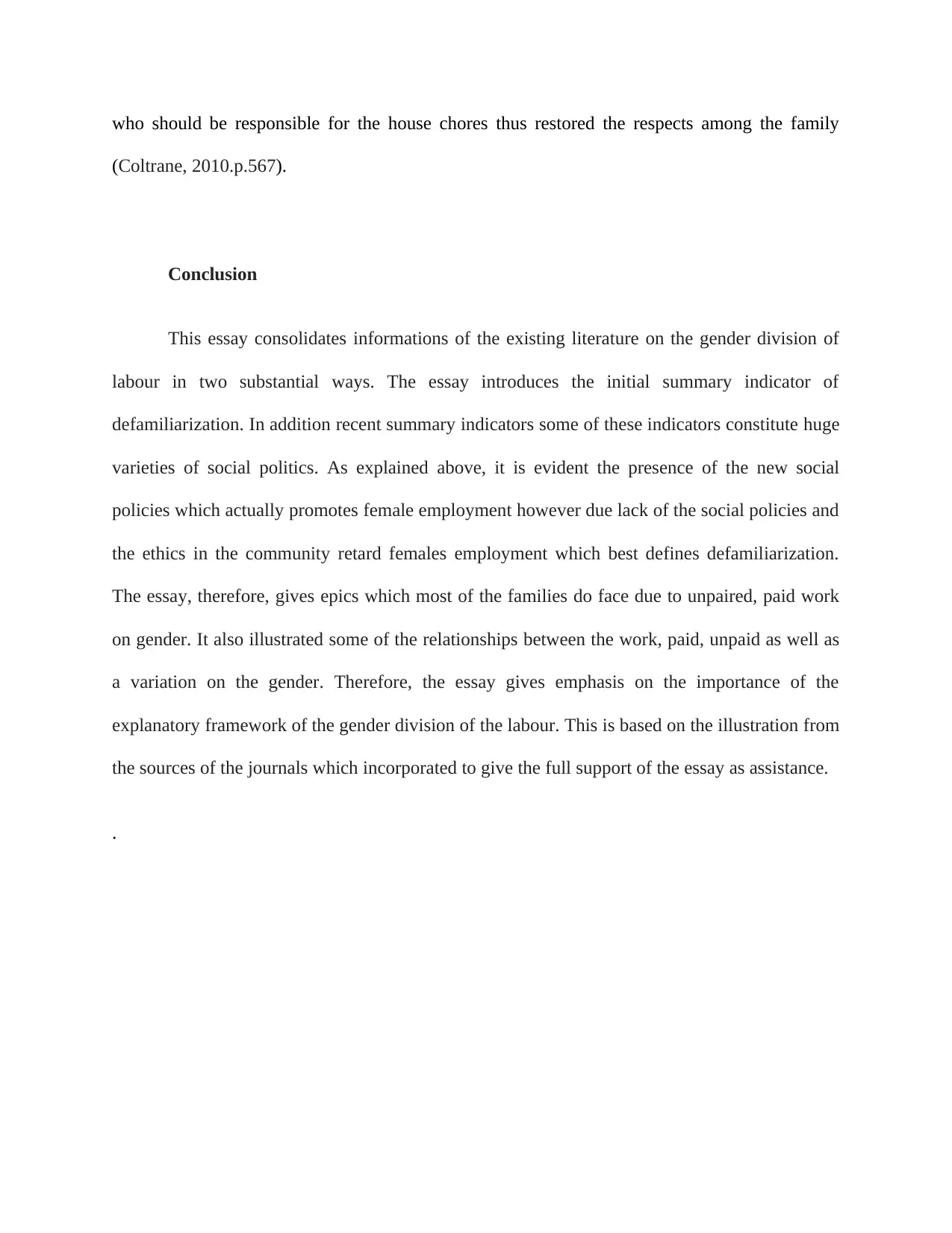
who should be responsible for the house chores thus restored the respects among the family
(Coltrane, 2010.p.567).
Conclusion
This essay consolidates informations of the existing literature on the gender division of
labour in two substantial ways. The essay introduces the initial summary indicator of
defamiliarization. In addition recent summary indicators some of these indicators constitute huge
varieties of social politics. As explained above, it is evident the presence of the new social
policies which actually promotes female employment however due lack of the social policies and
the ethics in the community retard females employment which best defines defamiliarization.
The essay, therefore, gives epics which most of the families do face due to unpaired, paid work
on gender. It also illustrated some of the relationships between the work, paid, unpaid as well as
a variation on the gender. Therefore, the essay gives emphasis on the importance of the
explanatory framework of the gender division of the labour. This is based on the illustration from
the sources of the journals which incorporated to give the full support of the essay as assistance.
.
(Coltrane, 2010.p.567).
Conclusion
This essay consolidates informations of the existing literature on the gender division of
labour in two substantial ways. The essay introduces the initial summary indicator of
defamiliarization. In addition recent summary indicators some of these indicators constitute huge
varieties of social politics. As explained above, it is evident the presence of the new social
policies which actually promotes female employment however due lack of the social policies and
the ethics in the community retard females employment which best defines defamiliarization.
The essay, therefore, gives epics which most of the families do face due to unpaired, paid work
on gender. It also illustrated some of the relationships between the work, paid, unpaid as well as
a variation on the gender. Therefore, the essay gives emphasis on the importance of the
explanatory framework of the gender division of the labour. This is based on the illustration from
the sources of the journals which incorporated to give the full support of the essay as assistance.
.
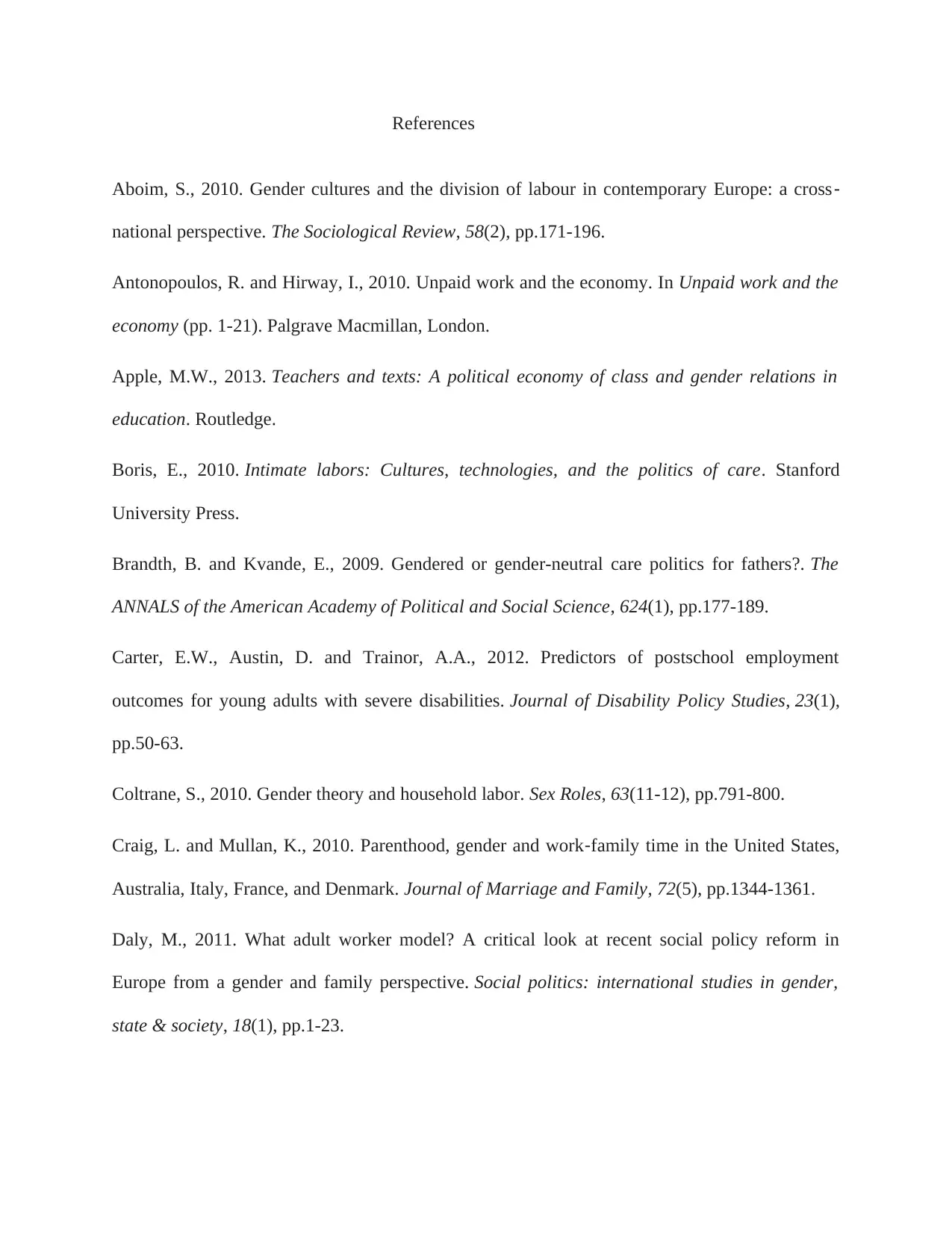
References
Aboim, S., 2010. Gender cultures and the division of labour in contemporary Europe: a cross‐
national perspective. The Sociological Review, 58(2), pp.171-196.
Antonopoulos, R. and Hirway, I., 2010. Unpaid work and the economy. In Unpaid work and the
economy (pp. 1-21). Palgrave Macmillan, London.
Apple, M.W., 2013. Teachers and texts: A political economy of class and gender relations in
education. Routledge.
Boris, E., 2010. Intimate labors: Cultures, technologies, and the politics of care. Stanford
University Press.
Brandth, B. and Kvande, E., 2009. Gendered or gender-neutral care politics for fathers?. The
ANNALS of the American Academy of Political and Social Science, 624(1), pp.177-189.
Carter, E.W., Austin, D. and Trainor, A.A., 2012. Predictors of postschool employment
outcomes for young adults with severe disabilities. Journal of Disability Policy Studies, 23(1),
pp.50-63.
Coltrane, S., 2010. Gender theory and household labor. Sex Roles, 63(11-12), pp.791-800.
Craig, L. and Mullan, K., 2010. Parenthood, gender and work‐family time in the United States,
Australia, Italy, France, and Denmark. Journal of Marriage and Family, 72(5), pp.1344-1361.
Daly, M., 2011. What adult worker model? A critical look at recent social policy reform in
Europe from a gender and family perspective. Social politics: international studies in gender,
state & society, 18(1), pp.1-23.
Aboim, S., 2010. Gender cultures and the division of labour in contemporary Europe: a cross‐
national perspective. The Sociological Review, 58(2), pp.171-196.
Antonopoulos, R. and Hirway, I., 2010. Unpaid work and the economy. In Unpaid work and the
economy (pp. 1-21). Palgrave Macmillan, London.
Apple, M.W., 2013. Teachers and texts: A political economy of class and gender relations in
education. Routledge.
Boris, E., 2010. Intimate labors: Cultures, technologies, and the politics of care. Stanford
University Press.
Brandth, B. and Kvande, E., 2009. Gendered or gender-neutral care politics for fathers?. The
ANNALS of the American Academy of Political and Social Science, 624(1), pp.177-189.
Carter, E.W., Austin, D. and Trainor, A.A., 2012. Predictors of postschool employment
outcomes for young adults with severe disabilities. Journal of Disability Policy Studies, 23(1),
pp.50-63.
Coltrane, S., 2010. Gender theory and household labor. Sex Roles, 63(11-12), pp.791-800.
Craig, L. and Mullan, K., 2010. Parenthood, gender and work‐family time in the United States,
Australia, Italy, France, and Denmark. Journal of Marriage and Family, 72(5), pp.1344-1361.
Daly, M., 2011. What adult worker model? A critical look at recent social policy reform in
Europe from a gender and family perspective. Social politics: international studies in gender,
state & society, 18(1), pp.1-23.
⊘ This is a preview!⊘
Do you want full access?
Subscribe today to unlock all pages.

Trusted by 1+ million students worldwide
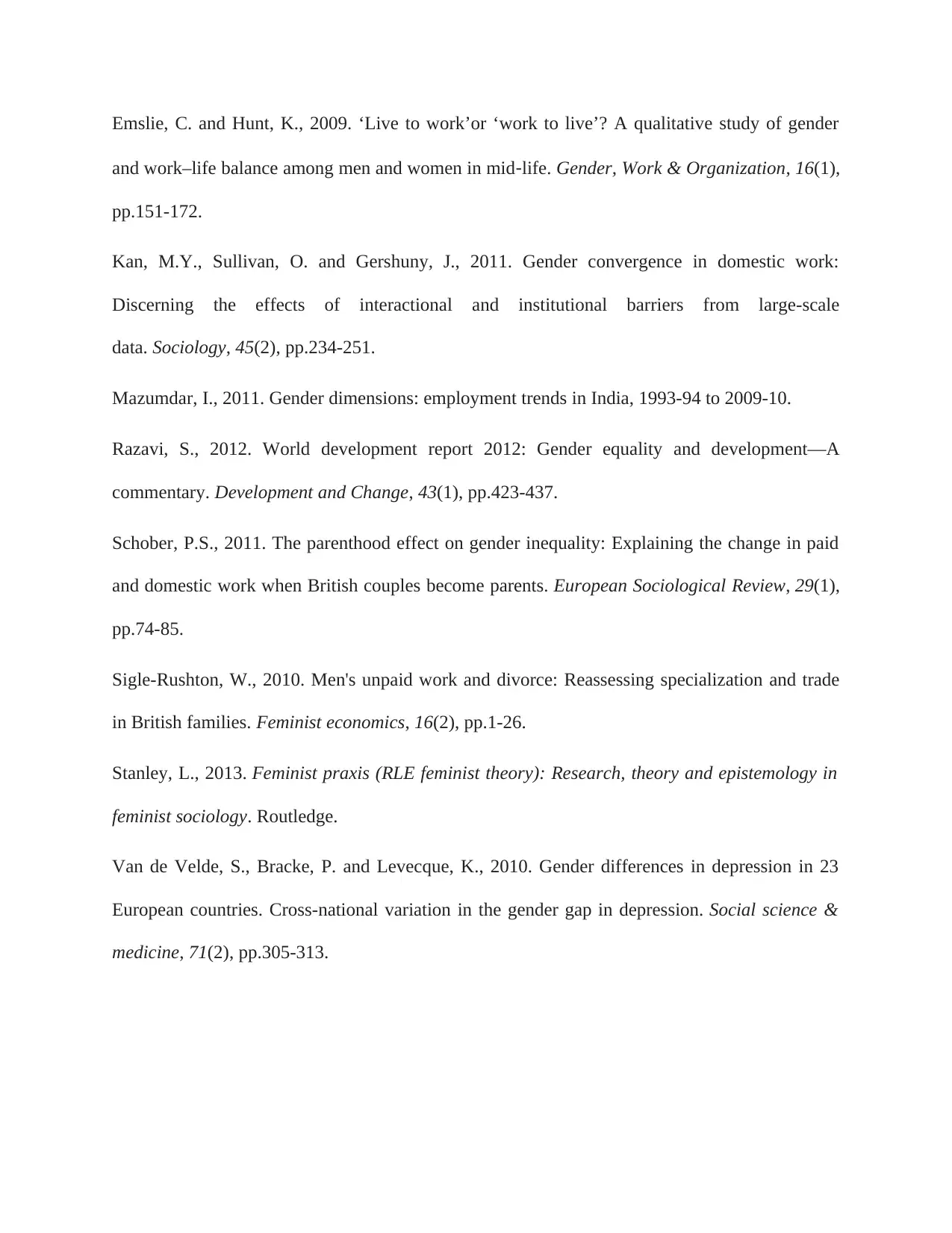
Emslie, C. and Hunt, K., 2009. ‘Live to work’or ‘work to live’? A qualitative study of gender
and work–life balance among men and women in mid‐life. Gender, Work & Organization, 16(1),
pp.151-172.
Kan, M.Y., Sullivan, O. and Gershuny, J., 2011. Gender convergence in domestic work:
Discerning the effects of interactional and institutional barriers from large-scale
data. Sociology, 45(2), pp.234-251.
Mazumdar, I., 2011. Gender dimensions: employment trends in India, 1993-94 to 2009-10.
Razavi, S., 2012. World development report 2012: Gender equality and development—A
commentary. Development and Change, 43(1), pp.423-437.
Schober, P.S., 2011. The parenthood effect on gender inequality: Explaining the change in paid
and domestic work when British couples become parents. European Sociological Review, 29(1),
pp.74-85.
Sigle-Rushton, W., 2010. Men's unpaid work and divorce: Reassessing specialization and trade
in British families. Feminist economics, 16(2), pp.1-26.
Stanley, L., 2013. Feminist praxis (RLE feminist theory): Research, theory and epistemology in
feminist sociology. Routledge.
Van de Velde, S., Bracke, P. and Levecque, K., 2010. Gender differences in depression in 23
European countries. Cross-national variation in the gender gap in depression. Social science &
medicine, 71(2), pp.305-313.
and work–life balance among men and women in mid‐life. Gender, Work & Organization, 16(1),
pp.151-172.
Kan, M.Y., Sullivan, O. and Gershuny, J., 2011. Gender convergence in domestic work:
Discerning the effects of interactional and institutional barriers from large-scale
data. Sociology, 45(2), pp.234-251.
Mazumdar, I., 2011. Gender dimensions: employment trends in India, 1993-94 to 2009-10.
Razavi, S., 2012. World development report 2012: Gender equality and development—A
commentary. Development and Change, 43(1), pp.423-437.
Schober, P.S., 2011. The parenthood effect on gender inequality: Explaining the change in paid
and domestic work when British couples become parents. European Sociological Review, 29(1),
pp.74-85.
Sigle-Rushton, W., 2010. Men's unpaid work and divorce: Reassessing specialization and trade
in British families. Feminist economics, 16(2), pp.1-26.
Stanley, L., 2013. Feminist praxis (RLE feminist theory): Research, theory and epistemology in
feminist sociology. Routledge.
Van de Velde, S., Bracke, P. and Levecque, K., 2010. Gender differences in depression in 23
European countries. Cross-national variation in the gender gap in depression. Social science &
medicine, 71(2), pp.305-313.
1 out of 10
Related Documents
Your All-in-One AI-Powered Toolkit for Academic Success.
+13062052269
info@desklib.com
Available 24*7 on WhatsApp / Email
![[object Object]](/_next/static/media/star-bottom.7253800d.svg)
Unlock your academic potential
Copyright © 2020–2025 A2Z Services. All Rights Reserved. Developed and managed by ZUCOL.





